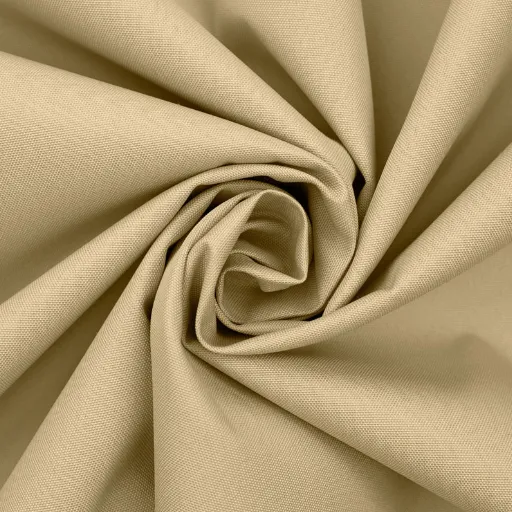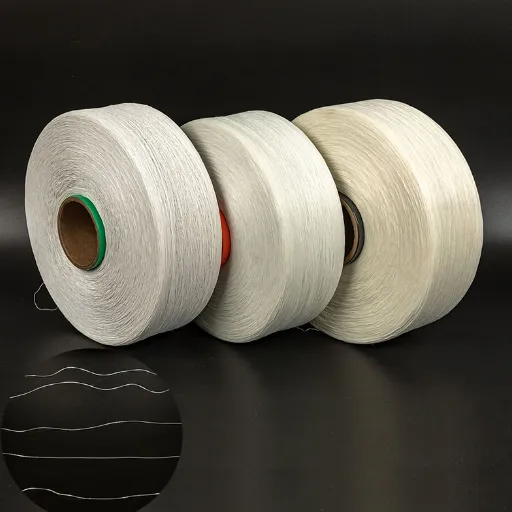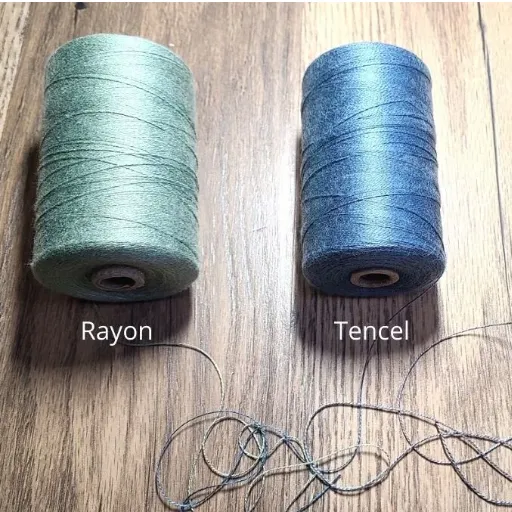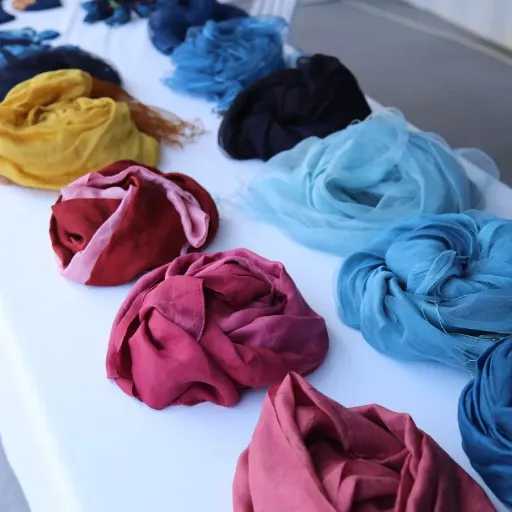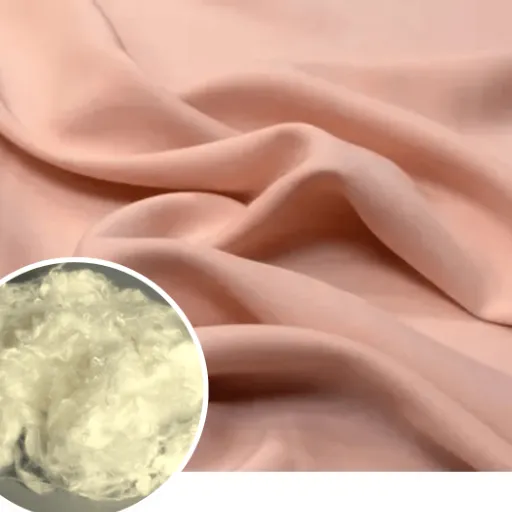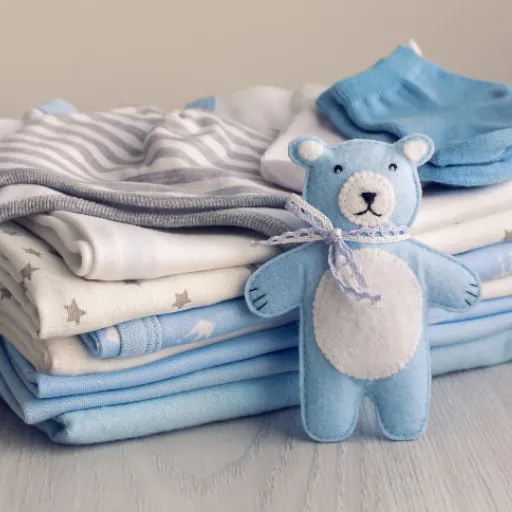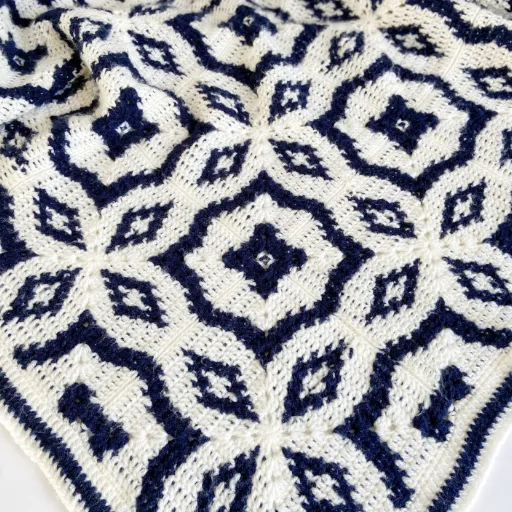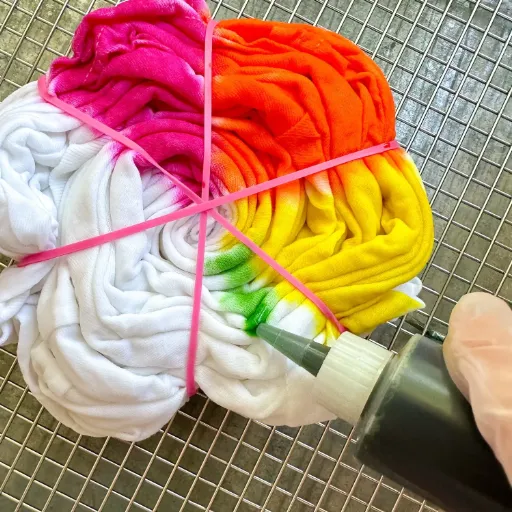An important aspect to consider when making a baby blanket is safety. Thus, in the midst of the making process, the common question that pops up is, “Is polyester yarn safe for baby blankets?” Polyester yarn sells quite well due to the cheap price, long durability, and very soft feel with which it comes to the skin. However, in acquiring a baby blanket for their baby, they would much rather keep safety and comfort at the forefront. This article takes a look at some of the important points in choosing by checking the properties of polyester yarn, its probable influence on delicate baby skin, and if it is fit and safe for such a task. The guide will surely help you decide, occasionally queried by a few knitters with experience or a new one, and even a parent full of concern.
Understanding Polyester Fibers
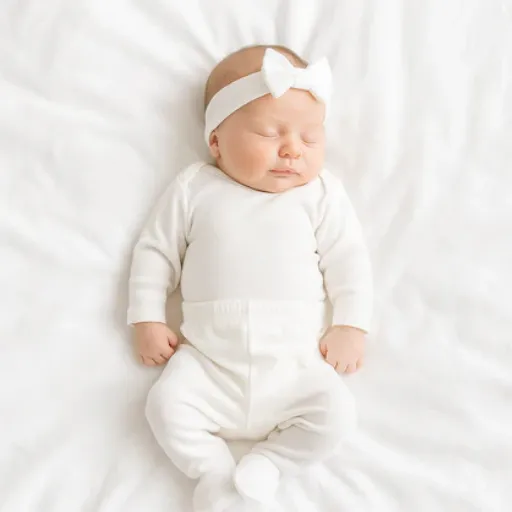
What Is Polyester Yarn?
Polyester fiber is one of those synthetic fibers created by a chemical process using petroleum-based products. It is engineered to be strong, light, yet resistant to common problems such as shrinkage, stretching, and wrinkling. Thus, the fiber is widely used in textiles for clothing, interiors, and crafts.
The very best features that characterize polyester yarn are strength and longevity. Unlike natural fibers, polyester resists abrasion due to wear and tear; therefore, heavy use hardly breaks down a polyester yarn. Furthermore, it keeps its shape very well and is practical to handle-truly a rapid drying and stain repellent. Such a base of practicality gives crafters ample reasons to choose this yarn in making their blankets.
However, polyester yarn is not as breathable as cotton or wool and can hold heat, adversely affecting the comfort factor. Some babies are sensitive to polyester yarns used in some baby products like blankets. Most quality polyester yarns have been treated for softness and safety, yet, as a sensible maneuver, one should always check for safety and comfort.
💡 Key Consideration: For parents or knitters, it is best to consider softness and hypoallergenic properties in ensuring the yarn is appropriate for sensitive skin.
Chemical Composition of Polyester
The term polyester is applied to any synthetic polymer that is basically derived from polyethylene terephthalate (PET). PET is obtained by reacting ethylene glycol with terephthalic acid, which are two basic raw materials obtained from petroleum. The polymerization reaction produces long chains of molecules that are either spun into fibers or processed for various manufacturing purposes.
With its strong molecular structure, polyester has ester groups (-COO-) in its repeating units-giving it stature, durability, and resistance against environmental factors. Due to these characteristics, polyester finds use in apparel, home furnishings, and industrial applications. Because of its strength, it can retain shape despite being stretched through normal usage, resist wrinkles, and the fast drying property of the fiber makes it a good option for use both at home and through the manufacturer above.
It is environmentally concerning that polyester is petroleum-based. In the production of polyester, the leaching of greenhouse gases takes place, and the fabric does not biodegrade, hence lasting forever in the environment. An advancement has been made in recycling processes, such as making new fibers from old polyesters, to minimize the environmental impacts and usher sustainability into the textile industry.
Hypoallergenic Properties of Polyester
Because of their synthetic nature, polyester fabrics are commonly said to be hypoallergenic. Dust mites, molds, or pollen are considered common allergens prevented by these fabrics. They resist moisture absorption, hence obstructing the growth of bacteria or dust mites’ fungus that may instigate allergic reactions. Thus, polyester may be preferred for an individual suffering from sensitive skin in many applications, from wear to bedding.
Depending on how fabrics or fibers are processed or treated, one should bear in mind that the hypoallergenic nature of polyester can sometimes be questioned. In such cases, the garment may have dyes, coatings, or chemicals that may irritate an individual with extremely sensitive skin to be irritated. Therefore, when possible, it is best to select untreated or minimally processed polyester.
Polyester has many advantages, but it is possibly unsuitable for everyone. A person who is usually sweaty may find that polyester keeps heat and moisture against the skin, causing great discomfort and irritation. For this very reason, polyester can prove to be a great hypoallergenic choice for many, but one must always weigh the requirements and preferences of the individual before choosing this fabric.
Safety Concerns with Polyester Yarn for Babies

Potential Health Risks of Polyester for Babies
Polyester, while the favorite fabric for most, may carry some health hazards for babies. Foremost is the breathability: it lacks just that. Lack of breathability leads to overheating. A baby experiences trouble in regulating his temperature, so a heat-accumulating fabric like polyester could lead to rashes, discomfort, or some kind of heat-related problem.
The other concern is that it may irritate. Some babies with sensitive skin or perhaps with dermatological problems like eczema may react adversely when in prolonged contact with this fabric. As a synthetic fiber, it may irritate fine skin or worsen the existing sensitivity and result in redness, itching, or dryness.
Lastly, chemicals necessary for polyester production must also be taken into consideration. Polyester fabrics might have some residues left from the dyes and finishes here or there to be leached out in conditions like sweating or moisture. Babies stand a bigger possibility of absorbing these chemicals due to their bodies’ ability to make and relatively permeable skin; hence, natural or organic fibers may be a safer choice for baby clothes and bedding.
Breathability and Comfort for Sensitive Skin
Natural fibers like cotton, linen, and wool traditionally offer greater breathability and gentleness for sensitive skin as opposed to synthetic fibers such as polyester or nylon. Through their breathable nature, they facilitate free airflow over the surface of our skin, minimizing the heat buildup and irritation associated with the sweating process; thus, they aid persons with sensitive skin in maintaining a temperature balance and protection against heat rash.
Natural fiber encompasses some that contain relatively little in the way of chemicals used in the treatment of synthetic fibers. Grown without synthetic pesticides or fertilizers, organic cotton is an even safer alternative for sensitive skin, especially for babies or persons prone to allergic reactions. Being free of chemically-based finishing agents is another way to cut down on potential skin irritations.
For a person with sensitive skin, friction and discomfort should be kept to a minimum; hence, the light, soft, and cheap fabrics are recommended. Fabrics with a looser weave pose additional benefits in terms of air circulation and comfort. When selecting clothing or any fabric for that matter-bed linen, for instance, is best to check the label for the materials used and choose those labeled “hypoallergenic” or “dermatologically approved.” This is always a good guarantee to adhere to for safety and good quality.
Common Irritants in Polyester Fabrics
The very synthetic nature of polyester and the chemicals involved in its making can sometimes spell trouble for delicate skin. The irritants might be the remnants of chemicals used in the production, such as dyes or finishing agents. Those with sensitive skin may bump or feel an allergic reaction as they come in direct contact with the irritant on the fabric.
Since polyesters are less breathable, after all, polyester has the ability to trap heat and moisture against the skin, which creates an itchy, rashy environment that worsens skin problems like eczema. This is pronounced in summer humid weather and whenever there is profuse sweating.
👕 Tip: Before wearing a polyester garment for the first time, it is recommended to wash it to remove the residual chemicals that may irritate. Another option could be polyester blends with natural fibers like cotton so that the fabric’s breathability is retained, and along with that reduces the feeling of discomfort. If a person has extremely sensitive skin, the best decision would be to avoid wearing polyester and, instead, opt for hypoallergenic and dermatologically tested fabrics to bring them comfort and safety.
Comparing Polyester with Natural Fibers

Polyester vs. Cotton: Which One Is Safer For Baby Blankets?
When it comes to baby blankets, cotton is considered safer than polyester, mostly because of its natural composition and suitability for sensitive skin. Cotton is soft, breathable, and hypoallergenic, whereas babies with sensitive skin might get irritated by anything else. It also works well to regulate temperature, keeping the baby comfortable under different conditions.
Meanwhile, polyester is a synthetic fabric, one that doesn’t quite offer good breathability, unlike natural fibers does: cotton. While polyester is very durable, lightweight, wrinkle-resistant, and colorfast, it does trap heat and moisture, creating an uncomfortable environment for babies, sometimes even overheating them. Some polyester fabrics might also contain chemical residues from their manufacture that might really irritate sensitive skin, especially when the fabric has not been treated or certified as safe for infant use.
✅ Verdict: Well, cotton continues to be the safer choice for baby blankets and is often preferred for newborns and infants with sensitive skin. Cotton is very comfortable and great for air circulation and protects babies well from cold. Polyester could work for something else, but in terms of baby safety, natural cotton has got to be the best choice.
Wool and Bamboo: Do They Make Better Options?
Wool and bamboo could be baby blanket options, each bestowing a different advantage. Wool is also a fiber made by nature, giving it its depiction as an excellent insulator in cold conditions. Also, it is considered to be moisture-wicking: water vapor does not remain suspended, but rather absorbed and released. This provides additional comfort by regulating temperature.
Many times, it is a subject of complaint as a common irritant on delicate skin, mainly if untreated or not appropriately classified for infant use. Bamboo is a sort of softness and is considered hypoallergenic. It is naturally breathable and silky smooth to the touch, thus serving as an excellent choice for babies with sensitivities to other fabrics. Other properties of bamboo include its light weight and antibacterial nature, all of which can come in handy when trying to keep the environment fresh and hygienic for your baby.
Finally, a choice between wool and bamboo comes down to what the baby actually needs. For warmth and moisture control, wool may be better, given it is baby-friendly and not irritating. If absolute softness and lightness with delicate handling of sensitive skin are advocated, then bamboo is the way to go. Past this point, one should ensure that the materials are certified for safe usage by babies to make sure that the baby is comfortable while the parents are at peace.
Overall Safety: A Comparative Analysis
In terms of overall safety for baby products, these two types of fabric each have merits, but each also requires scrutiny before weighing its potential for suitability. Wool acts as a natural insulator and temperature regulator; hence, it would be an excellent choice in a colder climate. Wool is also naturally flame-resistant and antimicrobial, promoting its general safety for infants. It is imperative to ensure that the wool is treated so that it cannot irritate or contain harmful chemicals, as some types of untreated wool may irritate sensitive baby skin.
In contrast, bamboo scores well for its softness and hypoallergenic qualities; it is very gentle on sensitive skin or skin that is allergic. Because bamboo fabrics wick moisture away from the skin and are breathable in nature, one will not feel too much heat in warm weather. However, the safety of bamboo garments will vary, depending upon the manner of processing used. Some methods include harmful chemicals and residues. Hence, parents should go in for bamboo articles that are labeled as being produced under an environmentally friendly and baby-safe process.
One can say that both wool and bamboo are safe options for babies if appropriate precautions are taken. Always look for certifications that guarantee that the materials are free from harmful substances and meet safety standards. Parents must assess the specific needs of their baby based on climate, sensitivity, and comfort so that the choice may be more well-informed. Choosing high-quality, certified products for their babies ensures safety and well-being, while also gaining from the special features of these fabrics.
Choosing Baby-Safe Materials
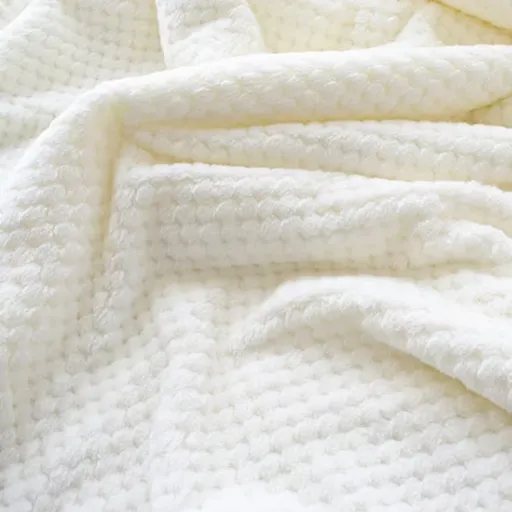
Certifications Behind Various Baby Products to Look For
While picking baby-safe products, one needs to consider many critical certifications along the way. Notable among these is the celebrated OEKO-TEX® Standard 100 certification. It guarantees that textiles have been tested against harmful substances and are at least safe for sensitive skin. Products bearing this tag can be trusted not to harm a baby’s sensitive skin with harsh chemicals.
The Global Organic Textile Standard (GOTS) certification is also vital. It certifies that the product has been formed from organic fibers while meeting strict environmental and social criteria. The GOTS-certified products are terribly safe for babies on account of their being procured without toxic chemicals or pesticides!
In the case of cribs, mattresses, and other baby furniture, look for testing certificates such as GREENGUARD Gold. The designation means that some very strict criteria were met in testing for the emission of chemicals into the surrounding air. This, in turn, improves indoor air quality. By seeking out these certifications, parental can be cleverly exercised in choosing safe and reliable materials for their baby.
| Certification | Purpose | Best For |
|---|---|---|
| OEKO-TEX® Standard 100 | Tests textiles for harmful substances | Clothing, blankets, bedding |
| GOTS | Certifies organic fibers and eco-friendly production | Organic cotton products |
| GREENGUARD Gold | Tests for chemical emissions and air quality | Cribs, mattresses, furniture |
Tips for Selecting Baby-Safe Yarn
Material should be foremost in consideration when selecting baby-safe yarn. It should be prepared from natural fibers like cotton, bamboo, or wool, as these are very soft to a baby’s sensitive skin. They are good at absorbing moisture, so babies rarely get irritated or discomforted. It must be established that the yarn does not contain synthetic additives or harsh chemicals because a child usually puts the yarn into the mouth or comes in contact with the stuff made from this yarn.
Another factor of consideration is the texture of the yarn. Yarn that is hypoallergenic or is labeled for the baby is another keyword for selecting yarn. The yarn should feel as soft and smooth as possible-the opposite of anything that feels rough, scratchy, or has loose fibers that might pose a safety risk. Also, check if the yarn is machine washable since baby items are usually cleaned quite often.
Finally, consider safety and certification. Look for yarns that meet the required safety standards, or yarns dyed with non-toxic, baby-safe dyes. Avoid yarns with tiny embellishments like metallic threads or sequins; these can pose choking hazards. In paying attention to these issues, you can be confident that the yarn you choose is as safe as it is functional and fun to work with on baby items.
🧶 Yarn Selection Checklist
- ✓ Natural fibers (cotton, bamboo, or wool)
- ✓ Hypoallergenic and labeled for babies
- ✓ Soft and smooth texture
- ✓ Machine washable
- ✓ Non-toxic dyes
- ✓ No embellishments or choking hazards
Understanding Fiber Made for Baby Clothing
Comfort, safety, and practicality are the foremost considerations while selecting fibers for baby clothing. Most of the time, natural fibers like cotton, bamboo, and merino wool are preferred since they are soft, breathable, and hypoallergenic. They minimize irritation on an infant’s sensitive skin and work well with scenarios of temperature changes for full comfort.
Safety is also another factor to be considered. Choose fibers that had no harsh chemicals and dyes and have been tested to meet baby-safe standards. Organic cotton is, consequently, a preferred choice for its minimal exposure to pesticides or hazardous residues. Besides, fibers that have loose strands or adornments might pose risks such as choking or entanglement and should be avoided.
Lastly, there is practicality. Parents and caregivers need clothing fabricated from fibers that are easy to wash and maintain. Such options are usually machine washable and durable enough to save time and effort and keep the clothing in good shape, even with frequent washing. Balancing all these ensures comfort and safety, and ease of use, both for the baby and the caregiver.
Caring for Polyester Baby Items
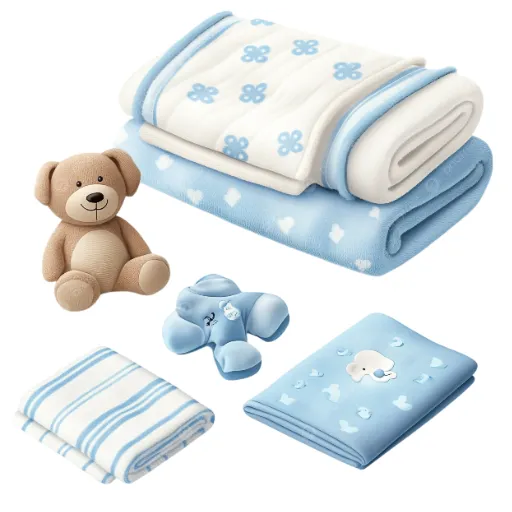
Washing and Maintaining Polyester Blankets
All baby polyester blankets require a simple hand wash. The material is sturdy and very easy to clean. However, one should preferably use warm or cold water on a gentle cycle to wash polyester blankets. Using a mild detergent is recommended because strong ones can penetrate the fibers, leaving them harsh and perhaps irritating the baby’s sensitive skin.
In drying, it is best to tumble dry on low or line dry to preserve the integrity of the fabric. Never subject the blankets to high heat, as this may degrade the polyester fibers or cause shrinkage. Also, do not use fabric softeners, as they restrict the fabric’s ability to breathe by leaving a residue.
For any stains, pre-treat the affected area with a gentle stain remover or a small amount of dilute detergent. Remember to always check the care label for special instructions; following these instructions ensures that your blanket stays protected for years to come while remaining soft, cozy, and safe for your baby.
🧺 Care Instructions Summary
Tips for Avoiding Allergic Reactions
Taking the right precautions can help prevent allergic reactions by picking hypoallergenic fabrics and materials. Think about using blankets bearing natural fibers such as organic cotton or bamboo, which are less likely to irritate sensitive skin. Avoiding things treated with chemical dyes or harsh finishes is also many times wrong because they might irritate the skin or cause discomfort in an already allergic baby.
Cleaning the baby blanket regularly also cuts down on allergens like dust mites, pollen, or pet dander. Use a mild, fragrance-free detergent suitable for sensitive skin and rinse all the way to ensure no detergent is left on the fabric. Choose a gentle wash cycle using lukewarm water to ensure that delicate fabrics are not damaged during the cleaning process but unstained and free from allergens.
Keep an eye on your baby any signs that bother him, like redness, rashes, or scratching that won’t go away. Treat diaper rash immediately when your child begins to show symptoms of an allergic reaction to an object. Stop using that child’s item that is suspected to contain an allergen and get a pediatrician’s advice. When in need, implement gentle treatment options with safe materials to keep allergic reactions at bay, and let your baby stay comfortable and healthy.
Creative Project Ideas Using Baby-Safe Polyester Yarn
The baby-safe option of polyester yarn is soft, durable, and hypoallergenic for crafting some cute, useful hand-made stuff for infants and toddlers. Here are some simple, yet elegant, creative project ideas that can help in restoring baby’s comfort and style:
🧸 Baby Blankets
Create a pretty, lightweight, and cozy baby blanket from soft polyester yarn. These blankets are so soft on a baby’s delicate skin, and they are available for custom colors and pretty patterns. Go with breathable designs such as loose crochet or knitted stitches that keep the baby warm without overheating.
👒 Baby Hats and Booties
A great practical project worth considering for baby-safe yarn includes knitting or crocheting baby hats and booties. These items will keep the little one warm and protected in winter. Go crazy creatively by adding those little touches―a little pom-pom, braided ties, and so forth―for more flair and functionality.
🐻 Stuffed Toys
For making handmade stuffed toys or plush animals, use any baby-safe polyester yarn. Such soft and hypoallergenic kinds of toys allow babies to hug them, and they are offered in different shapes like teddy bears, bunnies, or even simple shapes, making them an enjoyable, safe companion for your child.
Whichever baby-safe project you choose to take on, you are sure to create memories for life while ensuring your little one has comfortable and safe things to use every day.
Frequently Asked Questions (FAQ)
Q: Is polyester yarn safe for a baby?
A: Usually, polyester yarn is considered safe for babies. A synthetic fiber that is strong and durable makes it a good choice for baby items. However, if the yarn is hard or contains chemicals harmful to the baby, it could cause discomfort to them.
Q: What are the possible sets of hazards in the use of polyester for baby items?
A: While polyester is an ordinary manufactured material, potential doubts may arise for some parents. In some instances, polyester and other synthetics might increase the possibility of skin irritation or allergy-although cool parents with babies whose skin is exceedingly sensitive. Hence, it is wise to keep a watch for any adverse reaction.
Q: Does polyester yarn irritate the skin of babies?
A: Skin irritation to a few babies with this yarn could be a possibility, especially with those with eczema. One should buy soft and good-quality polyester yarn and observe all reactions they can notice on the baby’s skin.
Q: What are the differences between polyester yarn and natural fabrics for babies?
A: Natural fabrics such as cotton or wool are usually preferred for babies because of their breathability and softness. However, the majority of polyester products are made to be soft on the baby’s skin. Selecting yarn would depend on the fabric that best suits your baby.
Q: Can recycled polyester be used for baby items safely?
A: By nature, recycled polyester is recycled plastic and is mostly considered safe to use for baby products; it has greater durability than the normal kind of polyester to reduce its impact on the environment. However, always make sure that the recycled polyester yarn is certified to be free of hazardous chemicals.
Q: What are the considerations I have to make for baby blanket yarn selection?
A: While selecting yarn for a stroller blanket or baby blanket, make sure to select a yarn that is soft, hypoallergenic, and free of harmful chemicals. Polyester yarns can be a good choice, but high quality should be ensured to prevent any irritation.
Q: Will polyester regulate a baby’s body temperature?
A: Polyester does have a kernel of truth in it to keep temperature regulated and made fit for all weather conditions. Still, it is vital to watch your baby to avoid any overheating, especially in the warmer climates.
Q: Are soft toys made of polyester safe for a baby?
A: If advertised as for babies and do not have any small parts that could pose choking hazards to a baby, then soft toys made of polyester are safe for babies. Make sure that the toys are washable and that the materials used in their manufacture offer a safe play environment.
Q: Which is more superior for baby products, polyester or acrylic yarns?
A: Both polyester and acrylic yarns are popular for baby products because of their durability and wrinkle resistance; nevertheless, acrylic yarn might feel a bit softer compared to polyester. So make your choice based on your baby’s sensitivity.
Q: What environmental threats occur from polyester yarns?
A: Being used with synthetic fibers, the polyester yarn may contribute to microplastics in the environment. Therefore opting for recycled polyester for that purpose would help lessen their incidence. When selecting yarns to be used in baby items, consider the eco-friendly alternative whenever possible.
References
- Is Polyester Safe for Babies? – Cuddle Sprouts
Discusses the general safety of polyester for babies and its impact on sensitive skin. - Is polyester yarn safe for babies? – PolyLion Yarns
Explains the properties of polyester yarn and its suitability for baby clothing. - The Truth About Polyester – AU Baby Shop
Highlights the chemical composition of polyester and potential health concerns. - Avoiding Harmful Chemicals. Is Polyester Safe for Babies? – Star Sweepers
Focuses on the chemical processing of polyester and its potential risks for babies.








